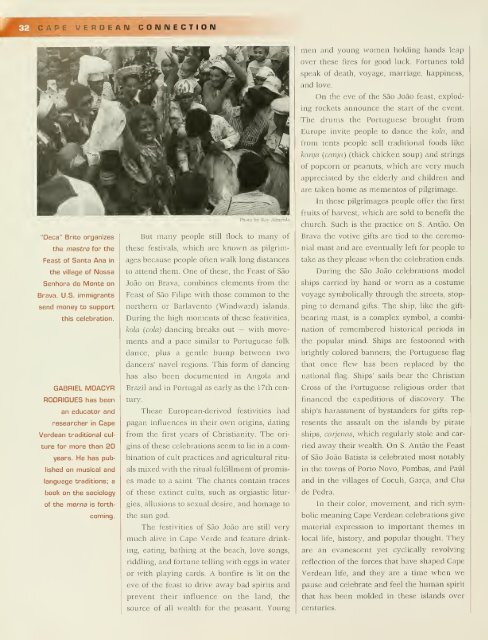American - Smithsonian Institution
American - Smithsonian Institution
American - Smithsonian Institution
Create successful ePaper yourself
Turn your PDF publications into a flip-book with our unique Google optimized e-Paper software.
VERDEAIVI CONNECTION<br />
"Deca" Brito organizes<br />
the mastro for the<br />
Feast of Santa Ana in<br />
the village of Nossa<br />
Senhora do Monte on<br />
Brava. U.S. immigrants<br />
send money to support<br />
this celebration.<br />
GABRIEL MOACYR<br />
RODRIGUES has been<br />
an educator and<br />
researcher in Cape<br />
Verdean traditional cul-<br />
ture for more than 20<br />
years. He has pub-<br />
lished on musical and<br />
language traditions; a<br />
book on the sociology<br />
of the morna is forth-<br />
coming.<br />
Photo by Ray Almeida<br />
But many people still flock to many of<br />
these festivals, which are known as pilgrim-<br />
ages because people often walk long distances<br />
to attend them. One of these, the Feast of Sao<br />
Joao on Brava, combines elements from the<br />
Feast of Sao Filipe with those common to the<br />
northern or Barlavento (Windward) islands.<br />
During the high moments of these festivities,<br />
kola (cola) dancing breaks out — with move-<br />
ments and a pace similar to Portuguese folk<br />
dance, plus a gentle bump between two<br />
dancers' navel regions. This form of dancing<br />
has also been documented in Angola and<br />
Brazil and in Portugal as early as the 17th cen-<br />
tury.<br />
These European-derived festivities had<br />
pagan influences in their own origins, dating<br />
from the first years of Christianity. The ori-<br />
gins of these celebrations seem to lie in a com-<br />
bination of cult practices and agricultural ritu-<br />
als mixed with the ritual fulfillment of promis-<br />
es made to a saint. The chants contain traces<br />
of these extinct cults, such as orgiastic litur-<br />
gies, allusions to sexual desire, and homage to<br />
the sun god.<br />
The festivities of Sao Joao are still veiy<br />
much alive in Cape Verde and feature drink-<br />
ing, eating, bathing at the beach, love songs,<br />
riddling, and fortune telling with eggs in water<br />
or with plaj'ing cards. A bonfire is lit on the<br />
eve of the feast to drive away bad spirits and<br />
prevent their influence on the land, the<br />
source of all wealth for the peasant. Young<br />
men and young women holding hands leap<br />
over these fires for good luck. Fortunes told<br />
speak of death, voyage, marriage, happiness,<br />
and love.<br />
On the eve of the Sao Joao feast, explod-<br />
ing rockets announce the start of the event.<br />
The drums the Portuguese brought from<br />
Europe invite people to dance the kola, and<br />
from tents people sell traditional foods like<br />
kanja (canja) (thick chicken soup) and strings<br />
of popcorn or peanuts, which are very much<br />
appreciated by the elderly and children and<br />
are taken home as mementos of pilgrimage.<br />
In these pilgrimages people offer the first<br />
fruits of harvest, which are sold to benefit the<br />
church. Such is the practice on S. Antao. On<br />
Brava the votive gifts are tied to the ceremo-<br />
nial mast and are eventually left for people to<br />
take as they please when the celebration ends.<br />
During the Sao Joao celebrations model<br />
ships carried by hand or worn as a costume<br />
voyage symbolically through the streets, stop-<br />
ping to demand gifts. The ship, like the gift-<br />
bearing mast, is a complex symbol, a combi-<br />
nation of remembered historical periods in<br />
the popular mind. Ships are festooned with<br />
brightly colored banners; the Portuguese flag<br />
that once flew has been replaced by the<br />
national flag. Ships' sails bear the Christian<br />
Cross of the Portuguese religious order that<br />
financed the expeditions of discovery. The<br />
ship's harassment of bystanders for gifts rep-<br />
resents the assault on the islands by pirate<br />
ships, carjenas, which regularly stole and car-<br />
ried away their wealth. On S. Antao the Feast<br />
of Sao Joao Batista is celebrated most notably<br />
in the towns of Porto Novo, Pombas, and Paul<br />
and in the villages of Coculi, Garga, and Cha<br />
de Pedra.<br />
In their color, movement, and rich sym-<br />
bolic meaning Cape Verdean celebrations give<br />
material expression to important themes in<br />
local life, history, and popular thought. They<br />
are an evanescent yet cyclically revolving<br />
reflection of the forces that have shaped Cape<br />
Verdean life, and they are a time when we<br />
pause and celebrate and feel the human spirit<br />
that has been molded in these islands over<br />
centuries.

















